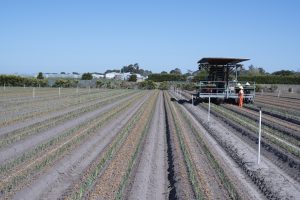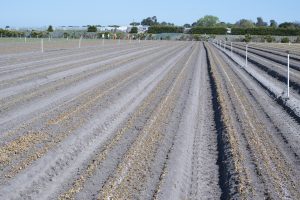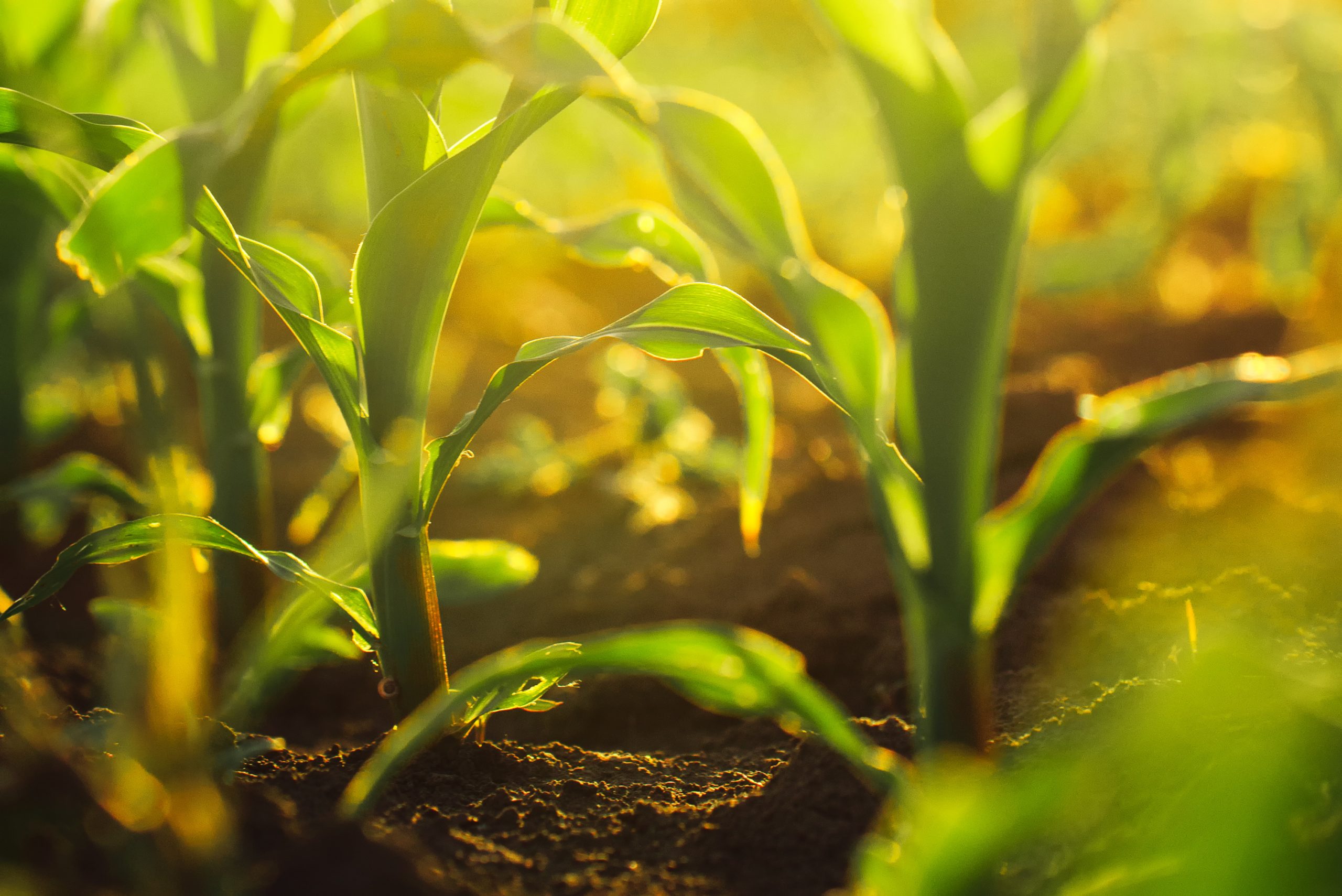Weed seed bank management using stale seed beds and inter-row cultivation
The team from the Hort Innovation-funded project A strategic approach to weed management for the Australian vegetable industry visited Schreurs & Sons in Clyde, Victoria in late-2019. In this article, Adam Schreurs speaks to the team about his willingness to innovate in Integrated Weed Management and improve his weed management approach by reintroducing some tried and trusted methods.
About Schreurs & Sons
The Schreurs family has been growing vegetables in the Cranbourne district, approximately 50 kilometres south-east of Melbourne, since the 1950s. Originally renowned for introducing Dutch carrots into the Australian market, Schreurs & Sons has now diversified into growing a variety of vegetable crops. These include celery, leek, spinach, rocket, and snow pea tendrils.
Today, Schreurs & Sons own five farms in the outer Melbourne suburbs of Clyde and Devon Meadows, totaling approximately 550 hectares. Across these farms, approximately 400 hectares are dedicated to vegetable production. The business employs about 180 staff, rotating across the five farm sites depending on need for ground preparation, planting and sowing, crop management, and harvest activities.
Adam Schreurs is one of several third-generation members of the family to remain involved in the business, and operates the business alongside his cousins Chris and Ben Schreurs.

Weed management concerns
Until the late 2000s, the weed management strategy used by Schreurs & Sons relied heavily on regular and relatively deep cultivation passes during the post-harvest and fallow period; a range of pre-plant and post-plant selective herbicides registered for use within their various crops; hand weeding to follow up on surviving weeds; and chemical fumigation.
However, for a variety of reasons the Schreurs & Sons team decided to change their weed management approach:
- Adam and his team became concerned about reduced herbicide effectiveness among the limited range of options available to them, noting a particular problem in managing common groundsel (Senecio vulgaris).
- Rather than employing their previous ‘calendar spraying’ approach, the team considered it would be more effective to use herbicides strategically and supplement them with other methods.
- As herbicides were becoming less effective, the team observed that cultivation and especially hand weeding costs were increasing. Diversifying the weed control methods used had the potential to reduce these costs over time.
- Reducing the number of relatively deep cultivation passes during the winter fallow period was also an attractive option, to maintain and improve soil health and structure.
- Adam and his team wished to move away from chemical fumigation due to concerns regarding its negative impact on human, animal and soil health.
- Schreurs & Sons is interested in shifting at least some of its land into organic celery production in the longer-term. Looking at ways to reduce the business’ reliance on herbicide therefore provided an opportunity to determine how effective alternative techniques may be.
Prior to the emergence of selective herbicides, the operation had relied heavily on cultivation and bed management before, within and after crops. The issues outlined above led them to consider reintroducing these techniques.
A new approach using old methods
As a result, since the late 2000s Schreurs & Sons has grown to rely more heavily on stale seed beds and inter-row cultivation as options for reducing reliance on regular herbicide application, and potentially reducing the cost of other weed management activities such as hand weeding. Subsequently, both methods have also become increasingly important in compensating for reduced herbicide effectiveness noted on the farm.
A stale seed bed involves preparing the crop beds well before the crop is planted. Several cohorts of weeds are allowed to germinate in the beds and controlled early each time using the broad-spectrum herbicide glyphosate. Usually, the seed bed is irrigated once to encourage a flush of weed germination. Glyphosate is applied to the beds approximately four weeks after the bed has been formed, to control any weeds that have emerged. Additional weed flushes are controlled if time permits. The crop is then planted into clean beds. Soil disturbance is minimised during planting to limit further weed germination.
This method suits the large scale of Schreurs & Sons production system, which features a winter fallow period between crops. This period is long enough for multiple cohorts of weeds to germinate and be controlled in the formed beds using the stale seed bed technique, before the next crop is sown or planted.

Inter-row cultivation suits many of the crops produced by Schreurs & Sons, which are grown in rows along the crop beds. In addition to removing many weeds within the crop row and in the wheel tracks, inter-row cultivation implements may provide some ‘hilling’ of the soil, potentially covering and suppressing other recently germinated small weeds.
Schreurs & Sons has two implements available to carry out inter-row cultivation. The first of these is a ‘Weedfix’ cultivator, using rotating tines. The second is a customised cultivator – fitted with Dutch hoes and knives – that has been set up specifically to suit the bed and row spacing used on the farm.

Both implements allow cultivation of the crop bed between the rows of crop plants, as well as on the sloped sides of the raised beds. Shallow inter-row cultivation is also completed within the wheel tracks by Adam and his team, using the customised cultivator.
The team usually uses inter-row cultivation twice, at least four weeks prior to harvest, and generally to a depth of 30 to 40 millimetres. The Weedfix cultivator is used within less mature crops, and the customised cultivator is used within more mature crops.
Among the crops grown on the farm, celery and leeks are particularly suited to inter-row cultivation because of their relatively upright form. However, inter-row cultivation is used to varying degrees within all crops grown by the business.
Schreurs & Sons continues to rely on several other weed control methods as part of its overall IWM strategy. These include cultivation to form crop beds, pre-plant and post-plant herbicides, and hand weeding to remove weed survivors.
Benefits of the new approach
The key principle of the Schreurs & Sons strategy is to minimise the number of weeds that mature and produce seed – particularly those weed species which they believe have started to show signs of resistance to herbicide. No matter what IWM approach is used, this principle is applicable to all vegetable farms.
Introducing stale seed beds and inter-row cultivation into the IWM strategy has successfully compensated for reduced herbicide effectiveness and helped Schreurs & Sons to gradually reduce the weed seed bank. Their ability to use herbicides more strategically helps to manage the risk of herbicide resistance. Reduced tillage during the winter fallow and during bed formation has been beneficial for soil health and soil structure.
Despite initially being slightly more expensive than the former, more herbicide-reliant strategy, the IWM strategy now used by Schreurs & Sons has helped improve overall farm profitability. This is due to improved crop yield and quality, reduced processing costs, and gradually reducing weed management costs as the weed seed bank is depleted.
Limitations of the new approach
Using the stale seed bed method successfully requires a sufficiently dry paddock to be able to drive the tractor along the crop rows while spraying glyphosate. If the paddock is wet for an extended period, it may be possible for weeds to establish and produce seed. This is particularly important for weeds that are capable of germinating, growing and producing seed rapidly. Therefore, relying on stale seed beds comes with a risk of replenishing the weed seed bank in particularly wet conditions.
Timing of inter-row cultivation is critical. This method is most effective when it is carried out early in the life of weeds – ideally, when weeds have just reached their first true leaf stage. Waiting until weeds have had the chance to grow much larger than this can reduce the effectiveness of this method. Because inter-row cultivation utilises shallow tillage, larger weeds may not be removed from the soil. Other issues resulting from late inter-row cultivation may include more mature weeds attaching themselves to the tines and re-establishing elsewhere in the paddock, and damage to the crop resulting from larger weeds dragging clods of soil through the crop lines.
Innovation is key
Adam’s willingness to innovate and continually explore new approaches, or to re-introduce ‘old’ approaches which are known to work well if used appropriately, is one of the keys to Schreurs & Sons ongoing success, not only in weed management but across the business.
With regards to weed management, Adam remains keen to explore alternative options despite the current success of the IWM strategy in place for Schreurs & Sons. Some options that have attracted his interest include cover cropping to suppress weeds during the fallow; thermal weed management (steam, flame or microwave); and a one-off chemical fumigant application to consider as a last resort to deplete particularly heavy weed seed banks.
Carl Larsen from RM Consulting Group is involved in the VegNET – Victoria (VG19012) and Soil Wealth ICP Phase 2 (VG16078) projects, among others. Carl considers Adam’s continued willingness to innovate will allow Schreurs & Sons to keep their weed burden to a manageable level in the longer term. His approach to innovation is suitable to all vegetable farms.

Further information
If you would like to learn more, a case study document is available for download from the project web page. Other weed management resources may also be downloaded.
You can also watch two videos with Adam Schreurs and Carl Larsen, discussing the Schreurs & Sons approach to on-farm innovation and IWM:
The VG15070 project team is grateful to Adam Schreurs and his team at Schreurs & Sons for sharing their story of successful Integrated Weed Management, and for their support of this project. We also appreciate the support of Carl Larsen from RMCG who shared his thoughts on innovation in IWM and vegetable farm management.
Find out more: Please visit une.edu.au/iwmvegetables or contact Michael Coleman at Michael.Coleman@une.edu.au or Paul Kristiansen at Paul.Kristiansen@une.edu.au.
A strategic approach to weed management for the Australian vegetable industry is a strategic levy investment under the Hort Innovation Vegetable Fund.
This project has been funded by Hort Innovation using the vegetable research and development levy and contributions from the Australian Government.
Project Number: VG15070

